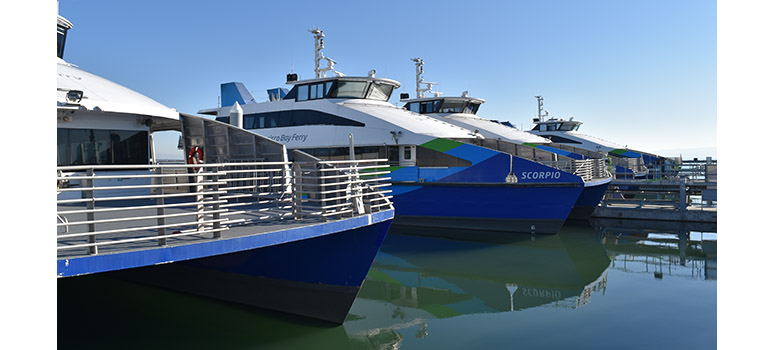Ferry Q&A debuts this month as a feature where you can have your questions about the ferry answered by the professionals who speak for the ferry systems on a daily basis.

WETA is increasing the size of the San Francisco Bay Ferry fleet significantly to prepare for expanded services and new routes with five new vessels in varying states of construction now. Expect to see two new vessels (Pyxis and Carina) to enter service within a couple of months. Photo by Joel Williams
Published: January, 2019
Ferry Q&A debuts this month as a feature where you can have your questions about the ferry answered by the professionals who speak for the ferry systems on a daily basis. Thomas Hall is the public information and marketing manager for WETA, the agency that runs the San Francisco Bay Ferry service. Priya Clemens is his counterpart at Golden Gate Transit. Their answers to your ferry questions are marked with a “WETA” and a “GG,” respectively.
Please submit your questions today to info@baycrossings.com.
Question 1: How many people ride the ferry on an average day?
WETA: San Francisco Bay Ferry carries an average of 10,000 passengers on weekdays and up to roughly 4,000 daily passengers on the weekend, depending on the weather. We’re getting close to carrying three million passengers on an annual basis—doubling our ridership over the past five years.
GG: We have more than 8,000 daily riders on the weekdays, and we average more than 4,000 on the weekends. Those are round numbers, but you can dig into the details by taking a look at our ridership stats here: goldengateferry.org/researchlibrary/statistics.php. There’s lots of information on the website about our ferry service overall. Check out our highest ridership days, details on our vessels, and more.
Question 2: Why don’t you run more vessels?
WETA: San Francisco Bay Ferry is adding vessels at a rapid clip—there might not be a water transit agency in the country ordering more ferries than WETA. We have five new vessels in varying states of construction right now, with two (Pyxis and Carina) due to enter service within a couple of months, two more (Vela and Lyra) due within the next year and another just underway (an unnamed 300-passenger vessel recently ordered). These vessels will be added to a fleet that has already added three new ferries since 2017: Hydrus, Argo and Cetus. We do have two vessel retirements coming up (Vallejo and Encinal), so these aren’t all pure additions to our fleet. But the size of the fleet is increasing, which will boost our ability to enhance service and expand to new terminals.
GG: We currently have seven vessels in the Golden Gate Fleet. We need every single one of them to make our service run so well through the busiest summer months. We’d also like to increase the number of trips we offer between Larkspur and San Francisco. In order to do that, we need to add another vessel. We have applied for a federal grant to help us pay for that vessel, and we are getting ready to embark on an environmental process to increase the number of trips we can run each day.
To pay for this extra service, we are discussing increasing bridge tolls. Golden Gate Bridge tolls not only pay for Golden Gate Bridge operations and maintenance, but they also go towards subsidizing Golden Gate Ferry and Golden Gate Transit bus service. We’d love to hear your opinion of our new toll ideas. For details on how to share your opinion, please visit goldengate.org.
We have several major fleet maintenance and upgrade projects coming in the months ahead, so we have leased a vessel from the east coast to help us cover service. The MV Millennium will be joining our fleet for one year, beginning in January. Keep an eye out for it, and enjoy the ride.
Question 3: Why does the ferry slow down so much in the Mare Island Strait?
WETA: There are wake restrictions in the Mare Island Strait due to homes, businesses and docks on the water. Our vessels slow down within the strait to minimize wakes and reduce the impact of wakes on those structures. This will also be the case on the new Richmond ferry route near Point Richmond, where the ferry will slow down to lower wake impacts for residents, businesses and docks on the waterfront.

